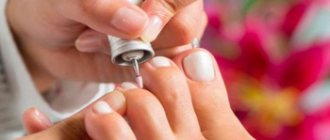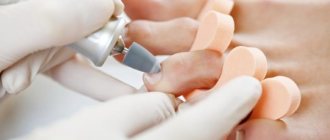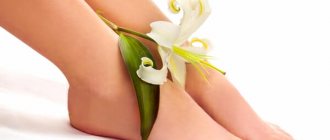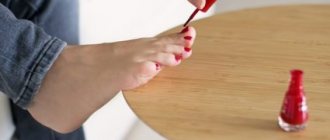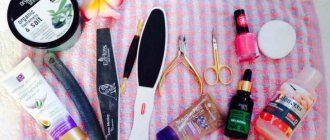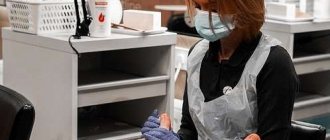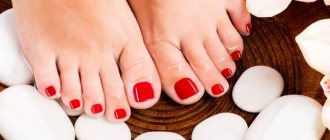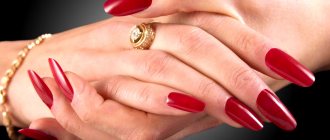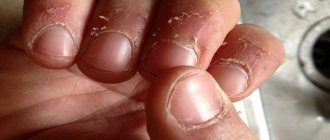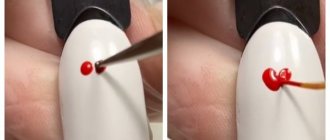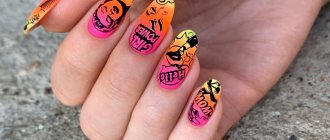- 73175
- 08-04-2021
- Author: Mysekret Team
- 0
Girls always want their legs to look beautiful and well-groomed - both in summer and winter. But few people know that you don’t have to go to a salon for a beautiful pedicure; you can do it yourself at home. This is especially true for those who like to wear sandals in the summer - beautiful and well-groomed toenails are especially important for them.
If a girl has beautiful, well-groomed nails, then she feels confident. Our article will tell you how to properly do a pedicure step by step. We will not use special equipment to perform it at home, which will allow you to enjoy this activity at any time.
If you want to have a skincare procedure done in a salon or beauty center, then pay attention to OLA centers.
See also...
✅ Light manicure is trending this year: 100 gentle ideas
✅ You need to be modern: we study the signs of outdated makeup
✅ The bob has grown: how to get a haircut when salons open
✅ It's time for a pedicure: fresh and stylish ideas for spring-summer 2021
50+ ideas for a fashionable pedicure here.
Pedicure at home: instructions
This is a completely simple procedure, it won’t take you much time, and the result will make others admire you! There are many ways to do a DIY pedicure at home. We'll look at step-by-step instructions on how to do it right!
Required Tools
For this you will need:
- high quality scissors and tweezers,
- orange stick,
- wire cutters,
- brush,
- file,
- cotton pads,
- and nail polish remover.
In addition to the above tools for pedicure at home, you must have a bath, scrub, callus and corn remover and, of course, foot cream. You can take any cream that you use daily, be it moisturizing or deodorizing.
If you have all these tools, then you can easily repeat the salon pedicure process. The main thing is to store them correctly. It is better to do this in a special cosmetic bag, clean and dry. After each use, thoroughly sterilize each item.
Pedicure: step by step
When creating a pedicure at home with your own hands, you should follow the instructions. So, let's consider all stages of the procedure.
Step 1: Start with a foot bath. Before performing this procedure, you should remove all nail polish. For it, you can use sea salt, soda, calendula or chamomile tinctures. Or you can buy a ready-made softener with an antibacterial effect. As the water in the bath cools, it should be filled with hotter water so that your feet are well prepared for the pedicure process. You should steam your feet for about 20-30 minutes, then wipe dry with a towel.
Step 2: removing corns. Next, you need to take care of your feet, removing all corns and calluses. They can be removed using a pumice stone or a razor specifically designed for this purpose. Walk the pumice stone in a circular motion over the entire foot - this will help get rid of dry skin. To give your legs a more well-groomed appearance, use a scrub. Distribute and massage your feet, toes and between your toes. After this procedure, rub the cream into your feet.
If there are calluses and cracks, you can remove them using tweezers .
Step 3: prepare the nail and cuticle. Under no circumstances should you cut the cuticle, just push it back with a stick. You can apply an emollient cream or oil for this. Next, the nails should be trimmed and filed, but do not round their edges. This can lead to ingrown nails and you can’t do it without the help of a specialist.
Don't forget about dirt under your nails! Clean it thoroughly!
Step 4: Applying varnish. The first layer is a transparent nail base. It will protect the surface. Apply colored varnish in one or two layers, allowing each of them to dry thoroughly. Apply a fixing varnish on top to prevent the color from chipping.
This completes the DIY pedicure at home! There is nothing complicated, the main thing is to learn how to do it correctly!
Differences from classic pedicure
In a classic pedicure, all stages of the procedure are quite standard. With a trimmed or hardware pedicure, old skin is removed (after soaking the feet in the bath), the length is removed and the shape of the nails is sharpened, and then the nails are covered with varnish.
SPA pedicure uses scrubs, essential oils, masks, wax, herbs, relaxing music and aromatherapy.
@harmonynails_ua
The master does not touch the nails, and does not use any sharp or abrasive tools. In this way, the risk of skin damage is completely eliminated, and as a result, the risk of injury is also eliminated. The top layer of dead skin cells is removed, and under the influence of special softening agents, corns and calluses disappear over time. This is exactly what distinguishes a classic combined pedicure from a spa procedure.
Also, unlike the gentle European pedicure, in which foot care consists only of sharpening the nails, a spa pedicure does not include this procedure.
@annaskoriukovamaster
@leol.t_ru
@pedicure_yagotin
Features of pedicure for older people
A medical pedicure for the elderly at home is performed in exactly the same way as a regular do-it-yourself pedicure at home. The most important thing here is compliance with antiseptic rules at the highest level. Because for them it’s not just about getting their nails in order. This is an opportunity to move painlessly.
The duration of such a procedure will be from forty to eighty minutes.
A hardware pedicure is best for older people because it does not require steaming the feet. Many older people suffer from varicose veins and other diseases for which steaming is not recommended. This method can be done for you any day; the best specialists work in Moscow and St. Petersburg.
What is a combined pedicure?
Pedicure is done in various ways - using special tools, hardware or spa. What does combined pedicure mean? This is a combination of individual methods into one procedure. It combines elements of hardware and trim pedicure, and also includes a spa.
In this case, the cuticles are removed by the master manually, and the skin of the fingers and feet is treated using a special device that includes several attachments for various purposes. To facilitate the process of removing corns, wraps are used. But let's talk about everything in order.
How to do a hardware pedicure correctly?
Care should be taken to properly perform a hardware pedicure with your own hands at home. But this activity is quite easy to learn. The main thing is to choose the right device for this.
The main advantage of this type of pedicure is that your feet do not need to be steamed in advance; it is enough to treat them well with an antiseptic.
Hardware pedicure step by step:
- Cuticle. Here the operation of the apparatus must be very careful. With light movements, you need to lift the cuticle from the center to the edges. And then sand thoroughly;
- Sinuses of the lateral ridges. Move in the direction of nail growth, away from the cuticle. It is better to use a cutter edge;
- Nail folds. Light non-stop movements with soft grinding;
- Treating the skin around the nail. Similar movements, but using an attachment specifically for this operation;
- Polishing the nail plate. This is where grinding and polishing attachments come to the rescue. This will help remove all irregularities and polish the plate to a shine.
As you can see, do-it-yourself hardware pedicure is quite simple to perform. Hardware manicure is performed according to the same scheme.
Hardware medical pedicure is prescribed in cases where an ingrown toenail, foot fungus, calluses, corns have appeared, or to improve the blood supply to the foot or to treat and prevent cracks.
This procedure should be carried out by a person with medical education, because it requires special knowledge. Wound healing creams and gels and disposable attachments are used, which eliminate the risk of infection.
The most popular devices for hardware pedicure and manicure:
- Saturn 3565 from Planet Nails;
- RM-25000 from Runail;
- Combi from Planet Nails.
Professional equipment will allow you to reduce the procedure time and improve its quality.
Medical pedicure technology
Upon closer examination of the technology for performing medical manicure, it becomes clear that it is not as complicated as it seems at first glance. However, here two fundamental points need to be taken into account: the need to maintain sterility and thorough treatment of the nail plate.
In order to comply with sanitary standards, it is necessary to create conditions where the possibility of the spread of fungus is completely excluded. Tools (files, finger separators) are used only for disposable use. Devices intended for reusable use (cutters for pedicure equipment, scissors and tweezers) are subject to mandatory sterilization immediately after the procedure. For this you need a special device. The possibility of replacing it with disinfectant solutions is excluded. Safety precautions are not limited to the use of sterilization equipment. You will also need gloves, a cap, a disposable gown, a medical mask, everything is disposable. These products should be used even if the pedicure is performed at home, because the dust that remains after grinding off the nail contains fungal spores and, scattering around, spreads them. There are special vacuum cleaners on sale that are designed to suck up nail dust. It is very good if it is used during a medical pedicure.
Antiseptic treatment
The first stage of pedicure is an antiseptic treatment, for which a special spray is used. It is generously applied not only to the nails and feet, but also to the hands of the master.
Preparing the skin of the feet
The skin does not always require any special treatment, in addition to the preventive application of antifungal agents, because often the fungus is localized only on the nails. But if the skin has also become damaged, then it requires treatment. It will be necessary to remove all manifestations of the disease and keratinized areas, after softening them. For this purpose, special products are used to help loosen rough skin and corns. They must be used according to the instructions.
Hardware treatment of foot skin
Regardless of whether we are talking about nails or the skin of the legs, everything unnecessary must be removed using a hardware method. The size of the nozzle that will be used to treat the foot should be selected according to the size of the keratinized area of skin. You may need to change attachments during the procedure. Extreme care must be taken to prevent injury to healthy skin and the formation of wounds and scratches.
Treatment of the nail plate
To begin with, the nail must be softened with special preparations. After this you can start grinding it down
It is important that all manifestations of the fungus are removed. The upper part of the nail is processed with a carbide cylinder, and then smaller cutters are selected
Be sure to examine the space between the edge of the nail and the nail fold. This can be done conveniently using a tampon holder.
Application of antifungal agents, massage
At the end of the procedure, you need to treat your nails and feet with antifungal drugs. The choice of a specific remedy is made by the doctor, guided by the test results. Applying medicinal ointments and creams to a worn-out nail plate is extremely effective, since in this case they do not have to penetrate through the keratinized areas of the nail. Medications are applied to the foot itself even if it is not affected by the fungus. Treatment of the feet is carried out with massage movements in order to enhance the effect of the medications.
Nail prosthetics
If the nail plate was significantly ground down during a medical pedicure, then you will have to reconstruct the nail using a special medical gel. This is necessary not only from an aesthetic point of view, but also to prevent infection, because the nail bed, if the nail itself is partially absent, is a “gateway” for the penetration of bacteria, viruses and fungi. Various materials can be used for prosthetics. Some of them harden on their own, and some only under ultraviolet rays.
Pedicure with gel polish at home
Pedicure with gel polish at home is very easy to do with your own hands. It lasts for more than 3 weeks, and its color does not lose its saturation over time.
For this you will need:
- Gel-varnish,
- Base and coating
- Nail degreaser,
- Cotton pads,
- UV lamp.
Application steps:
- First, let's remove the old polish, trim the cuticles and take care of the heels. After this, the nail is shaped, if it has not already been shaped.
- The base coat is applied immediately after degreasing the nail. This coating is kept under the lamp for about 2 minutes.
- The product is applied in 2 layers, each of which is also dried under a lamp.
- Top coat and its subsequent polymerization in a lamp.
- The sticky layer is removed and the oil is rubbed into the cuticle.
Preparation and application of coating
Once the cuticle and side ridges are prepared, you can begin coating. This requires nail preparation.
The surface of the nail plate must be sanded to remove all roughness. To do this, it is best to use a file with a medium abrasiveness of 240 grit. After this, the nails must be cleaned of dust and degreased.
If the client's fingers are straight, there is no need to use a special separator. If some fingers overlap each other, it is better to use a separator so that the coating does not rub off and dries thoroughly.
It is recommended to use a primer on your feet. It only treats the tip of the nail. It is not worth covering the entire surface, since a pedicure lasts longer than a manicure. And the primer dries out the nail plate with prolonged exposure.
The pedicure base can have a thick or medium-thick consistency. If you know how to quickly cover the nail and level it, you can also use the liquid option - a liquid base will help reduce the thickness of the layer.
Applying base coat
Having chosen a base that suits your needs, you can begin to coat your nails.
First, take a little material onto the brush and press one side of the brush against the neck of the bottle.
Place the drop of base obtained on the opposite side in the middle of the nail, not coming close to the cuticle.
Using light movements without pressure, distribute the base on the sides, moving the brush from top to bottom parallel to the side rollers. If you press the brush, the base will blur and “buns” will form on the surface.
At the cuticle, distribute the base with short, small movements. You can take an additional drop of material and, with light pressure, bring it to the cuticle, being careful not to go into the skin. There should be approximately 0.3 mm left to the cuticle.
After the gel is applied to the skin, you need to brush over the entire nail. To understand whether it is evenly distributed, you need to look at the end of the nail. In this position, it will be clearly visible where there is excess or deficiency of material.
You need to dry your thumbs immediately. The rest can be applied on 2 nails at a time. In this case, the leg should stand as straight as possible in the lamp. It is better to monitor the client for the first few seconds so that the coating has time to set and does not flow to one edge.
Drying time depends on the lamp - for LED models 30-60 seconds, for UV - 120 seconds.
Color coating
When applying color to a nail, the same rules apply as when applying a base coat. You need to take a small drop onto the brush so that the varnish does not flow to the sides. To begin with, cover the middle part of the nail and its base. Then the varnish is applied as close as possible to the rollers, leaving a small distance in the area near the cuticle.
The first layer should be as thin as possible, but without bald spots. To achieve an even coating, you can use a thin brush - you need to saturate it with color and treat problem areas. You should not go deep under the rollers or cuticle. It is better to leave a small space of 0.2-0.3 mm.
If the polish is not highly pigmented, reapplication will be required. 2-3 layers of gel polish are enough for high-quality coverage. Each layer must be applied using the same technology as the first. After each layer, the nails must be dried thoroughly so that the rays of the lamp fall on its entire surface. Otherwise, the coating may shrink and peel off.
Top coating
For toenails, it is recommended to use a topcoat with a sticky layer. This coating is more elastic, which is what is required in a pedicure. A non-sticky top creates a dense reinforcing surface, which can cause chipping on your feet due to the constant pressure of shoes on your toes.
The top is applied according to the same scheme as the previous coating layers. Using a small brush, you can carefully distribute the fixing material near the cuticle and in the area of the side rollers.
Design
After the top coat has dried, you can make the design. Rubs, glitter, rhinestones and stickers are suitable for pedicure. The main thing is that the selected design elements do not disturb the shape of the nails, because on the feet they should be as square as possible.
When applying rub or glitter, you don’t have to cover the side areas - you’ll get an emphasis on the center of the nail. It is better to lay out rhinestones in straight lines or geometric shapes. Do not forget that each design element must be covered again with topcoat in conclusion. Otherwise, the decorations will come off the nail.
If in doubt, the rhinestones can be fixed with special glue or the design can be covered with a jewelry fixative - this way the jewelry will definitely last until the next correction.
Do your clients prefer a plain coating on their nails or do they like to decorate their fingers?
All about pedicure technologies and necessary products >>
Comment
Products for high-quality pedicure at home
A good pedicure involves not only processing the cuticle and carefully applying gel polish. It is also important to clean your heels, get rid of foot fungus and take steps to get rid of bunions. Here are some good remedies to use at home:
Pedicure socks Baby Foot
These socks have been popular in Japan for more than 15 years and have finally reached us. They are extremely simple to use: put them on, wear them for 15-20 minutes, remove and wash the product off your feet. Around day 2-3, the rough skin will begin to peel off.
Nomidol cream for foot fungus
Fungus is a popular problem of our time, which is most often caused by poor hygiene and poor-quality shoes. You can get rid of fungus. choosing a quality product. One of these is Nomidol. In just a couple of days, the itching goes away, sweating decreases, and after 30 days the feet take on an absolutely perfect appearance.
Gel gloves and socks
If there is no fungus and there is no need to exfoliate rough skin, pamper yourself with gel gloves and socks for spa care. Silky skin and a feeling of complete relaxation are guaranteed. Experts recommend!
Ointment "ValgusStop"
A protruding bone on the foot, calluses and corns are also common problems that can be dealt with by choosing a quality product for home use. ValgusStop ointment gives noticeable results in just 1 month of use.
The main stages of work during a European pedicure:
- Feet are treated with disinfectant.
- The polish is removed from the nails.
- The nail plate is adjusted with a file and given the desired length and shape.
- The feet and cuticles are softened using a special product.
- Using an orange stick, the master carefully pushes back the cuticle.
- Feet are treated.
- Using a special nail file, the master delicately grinds down the cuticle and side ridges.
- Use a damp cloth to remove dust.
- The treated areas are disinfected with an antiseptic composition.
- The cuticle is moisturized and treated with nourishing oil.
- A light massage is performed to increase blood circulation in the foot.
At the client's request, the nails are varnished at the final stage.
Advantages of European pedicure:
- painless procedure;
- infection safety;
- with regular use, the thickness of the cuticle decreases, which allows you to use the services of a specialist less often;
- efficiency – the duration of the procedure is no more than 30-40 minutes;
- duration of effect is 2-4 weeks;
- children are allowed;
- affordable price.
European pedicure is not only an excellent effect, but also a practical, relaxing procedure.
Disadvantages of European pedicure:
- not suitable for unkempt feet;
- used only as a maintenance procedure;
- You can achieve a good result only after 3-5 visits to the salon;
- insufficient skin hydration;
- performed more often than a hardware pedicure.
After a European pedicure, feet must be regularly treated with moisturizing and nourishing cosmetics; specific names are recommended by a cosmetologist or podiatrist.
Pedicure 2022: fashion trends (photos)
More ideas for stylish pedicures and big toe designs here.
Share with your friends!
Read us in the Zen channel
Processing technology
In addition to the device itself and various attachments, you must first prepare consumables and the compositions to be applied:
- File;
- Bafik (for surface polishing);
- Metal pusher or orange stick;
- Brush;
- A machine that automatically draws sawdust from the machine;
- UV lamp;
- Top, base, colored gel polish, application brush;
- Decor for decorating nails.
Additionally, use an antiseptic to treat the surface of the feet and a degreaser, which increases the strength of the adhesion of the pigment to the nail.
